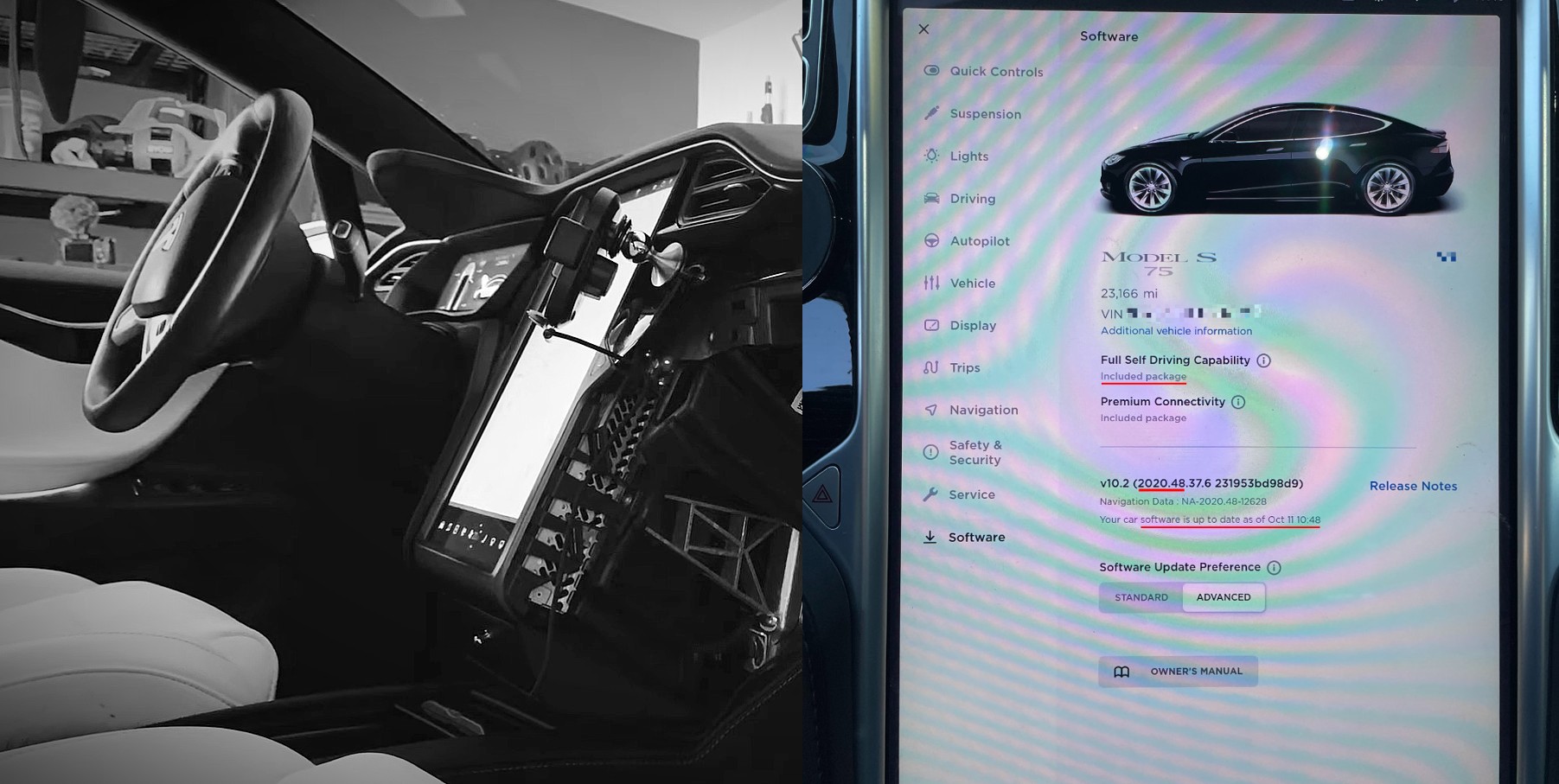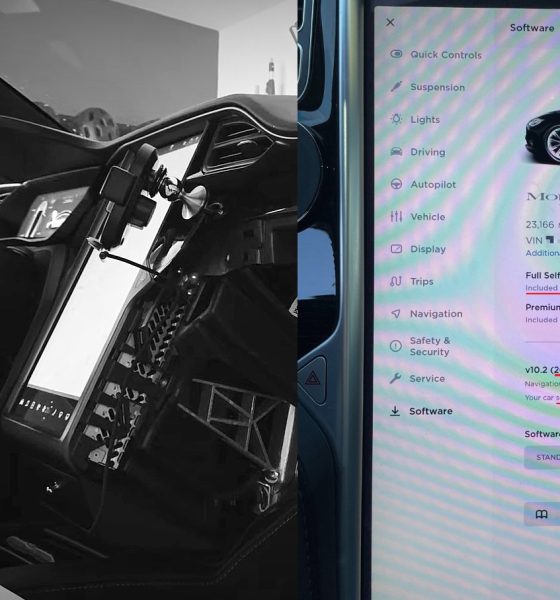

News
Tesla gives update for early FSD adopters with legacy Model S, Model X vehicles
Longtime Tesla FSD adopters with legacy vehicles recently received an update from the electric car maker. The update sheds some light on what is waiting for customers who purchased FSD and are still driving legacy Model S and Model X vehicles today.
Tesla functions like a tech company, so it is no surprise that it has moved very fast over the years. This means that constant improvements to its vehicles’ hardware are being implemented as soon as they are ready. This also means, however, that the latest updates to systems like FSD (Supervised) or Autopilot are mostly focused on vehicles that represent the majority of the company’s fleet.
This was highlighted by Elon Musk in a recent post on X, when he noted that while Tesla’s Hardware 4 will ultimately be better, all training that the company is doing right now is for Hardware 3 vehicles. Hardware 4 is just running on emulation mode.
Within Tesla’s pursuit of autonomous driving lies a group of Model S and Model X owners who bought into FSD even before the Model 3 was ramped. These owners were promised that their vehicles would have the necessary hardware to be self-driving one day, but they have not received much of Tesla’s Autopilot and FSD improvements to date. Granted, Tesla has launched a hardware upgrade program for legacy vehicles, but they are paid options that some owners have refused.
It was then no surprise that amidst the excitement for FSD (Supervised), some legacy Model S and Model X owners have expressed their frustration at being left out again. Among these is Anthony Spina, who noted in a post on X, that “all of us legacy S/X owners still haven’t received V12 yet, with no official communication stating whether or not we even will. MCU1 FSD S/X owners have been living in the dark on this for years, and now MCU2 owners are beginning to be lumped into this group as well, at least it would seem on the surface.”
Thanks @Speenuh and others who have posted on @X about this. While we normally prioritize our paid FSD customers to the extent possible, there is a group of S/X customers (~3% of total FSD eligible vehicles) who have a different hardware which the @Tesla_AI team is working to… https://t.co/W3l3SYlVZu— Rohan Patel (@rohanspatel) March 31, 2024
In a response on X, Tesla Vice President of Public Policy and Business Development Rohan Patel explained that the electric vehicle maker is putting a lot of efforts into releasing systems like FSD (Supervised) to older vehicles. The executive noted that Tesla cannot give a timeline as to when FSD would be released to older vehicles, but the company’s AI team is working on it.
“Thanks @Speenuh and others who have posted on @X about this. While we normally prioritize our paid FSD customers to the extent possible, there is a group of S/X customers (~3% of total FSD eligible vehicles) who have a different hardware which the @Tesla_AI team is working to validate. We have a rigorous safety validation cycle for every software update, and we are working as hard as possible to ship the latest builds to all customers. We don’t want to give false precision on timing until the validation can be completed, but want you to know we are focused on trying to solve this. Many of you have been with us on the FSD journey from the start and it’s super appreciated,” Patel wrote.
We ? get it and understand and sincerely appreciate the patience. Our software engineers and validation teams really are doing all they can to try and solve even on Easter Sunday.— Rohan Patel (@rohanspatel) March 31, 2024
In a follow-up post, the Tesla executive also noted that the company understands the frustration of its legacy customers. “We 100% get it and understand and sincerely appreciate the patience. Our software engineers and validation teams really are doing all they can to try and solve even on Easter Sunday,” the executive noted.
Don’t hesitate to contact us with news tips. Just send a message to simon@teslarati.cDon ‘t give us a heads up.

News
Tesla FSD fleet is nearing 7 billion total miles, including 2.5 billion city miles
As can be seen on Tesla’s official FSD webpage, vehicles equipped with the system have now navigated over 6.99 billion miles.

Tesla’s Full Self-Driving (Supervised) fleet is closing in on almost 7 billion total miles driven, as per data posted by the company on its official FSD webpage.
These figures hint at the massive scale of data fueling Tesla’s rapid FSD improvements, which have been quite notable as of late.
FSD mileage milestones
As can be seen on Tesla’s official FSD webpage, vehicles equipped with the system have now navigated over 6.99 billion miles. Tesla owner and avid FSD tester Whole Mars Catalog also shared a screenshot indicating that from the nearly 7 billion miles traveled by the FSD fleet, more than 2.5 billion miles were driven inside cities.
City miles are particularly valuable for complex urban scenarios like unprotected turns, pedestrian interactions, and traffic lights. This is also the difference-maker for FSD, as only complex solutions, such as Waymo’s self-driving taxis, operate similarly on inner-city streets. And even then, incidents such as the San Francisco blackouts have proven challenging for sensor-rich vehicles like Waymos.
Tesla’s data edge
Tesla has a number of advantages in the autonomous vehicle sector, one of which is the size of its fleet and the number of vehicles training FSD on real-world roads. Tesla’s nearly 7 billion FSD miles then allow the company to roll out updates that make its vehicles behave like they are being driven by experienced drivers, even if they are operating on their own.
So notable are Tesla’s improvements to FSD that NVIDIA Director of Robotics Jim Fan, after experiencing FSD v14, noted that the system is the first AI that passes what he described as a “Physical Turing Test.”
“Despite knowing exactly how robot learning works, I still find it magical watching the steering wheel turn by itself. First it feels surreal, next it becomes routine. Then, like the smartphone, taking it away actively hurts. This is how humanity gets rewired and glued to god-like technologies,” Fan wrote in a post on X.
News
Tesla starts showing how FSD will change lives in Europe
Local officials tested the system on narrow country roads and were impressed by FSD’s smooth, human-like driving, with some calling the service a game-changer for everyday life in areas that are far from urban centers.

Tesla has launched Europe’s first public shuttle service using Full Self-Driving (Supervised) in the rural Eifelkreis Bitburg-Prüm region of Germany, demonstrating how the technology can restore independence and mobility for people who struggle with limited transport options.
Local officials tested the system on narrow country roads and were impressed by FSD’s smooth, human-like driving, with some calling the service a game-changer for everyday life in areas that are far from urban centers.
Officials see real impact on rural residents
Arzfeld Mayor Johannes Kuhl and District Administrator Andreas Kruppert personally tested the Tesla shuttle service. This allowed them to see just how well FSD navigated winding lanes and rural roads confidently. Kruppert said, “Autonomous driving sounds like science fiction to many, but we simply see here that it works totally well in rural regions too.” Kuhl, for his part, also noted that FSD “feels like a very experienced driver.”
The pilot complements the area’s “Citizen Bus” program, which provides on-demand rides for elderly residents who can no longer drive themselves. Tesla Europe shared a video of a demonstration of the service, highlighting how FSD gives people their freedom back, even in places where public transport is not as prevalent.
What the Ministry for Economic Affairs and Transport says
Rhineland-Palatinate’s Minister Daniela Schmitt supported the project, praising the collaboration that made this “first of its kind in Europe” possible. As per the ministry, the rural rollout for the service shows FSD’s potential beyond major cities, and it delivers tangible benefits like grocery runs, doctor visits, and social connections for isolated residents.
“Reliable and flexible mobility is especially vital in rural areas. With the launch of a shuttle service using self-driving vehicles (FSD supervised) by Tesla in the Eifelkreis Bitburg-Prüm, an innovative pilot project is now getting underway that complements local community bus services. It is the first project of its kind in Europe.
“The result is a real gain for rural mobility: greater accessibility, more flexibility and tangible benefits for everyday life. A strong signal for innovation, cooperation and future-oriented mobility beyond urban centers,” the ministry wrote in a LinkedIn post.
News
Tesla China quietly posts Robotaxi-related job listing
Tesla China is currently seeking a Low Voltage Electrical Engineer to work on circuit board design for the company’s autonomous vehicles.

Tesla has posted a new job listing in Shanghai explicitly tied to its Robotaxi program, fueling speculation that the company is preparing to launch its dedicated autonomous ride-hailing service in China.
As noted in the listing, Tesla China is currently seeking a Low Voltage Electrical Engineer to work on circuit board design for the company’s autonomous vehicles.
Robotaxi-specific role
The listing, which was shared on social media platform X by industry watcher @tslaming, suggested that Tesla China is looking to fill the role urgently. The job listing itself specifically mentions that the person hired for the role will be working on the Low Voltage Hardware team, which would design the circuit boards that would serve as the nervous system of the Robotaxi.
Key tasks for the role, as indicated in the job listing, include collaboration with PCB layout, firmware, mechanical, program management, and validation teams, among other responsibilities. The role is based in Shanghai.
China Robotaxi launch
China represents a massive potential market for robotaxis, with its dense urban centers and supportive policies in select cities. Tesla has limited permission to roll out FSD in the country, though despite this, its vehicles have been hailed as among the best in the market when it comes to autonomous features. So far, at least, it appears that China supports Tesla’s FSD and Robotaxi rollout.
This was hinted at in November, when Tesla brought the Cybercab to the 8th China International Import Expo (CIIE) in Shanghai, marking the first time that the autonomous two-seater was brought to the Asia-Pacific region. The vehicle, despite not having a release date in China, received a significant amount of interest among the event’s attendees.








